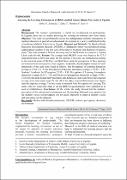Assessing the Learning Environment at Habib medical School, Islamic University in Uganda

Date
2017-01Author
Nazziwa, Aisha
Lwere, Kamada
Tebetyo, Zakia
Ankarali, Handan
Ankarali, Seyit
Metadata
Show full item recordAbstract
The learners’ environment is crucial for development of professionals. In Uganda, there was no studies assessing the learning environment have been found. Objective: This study was performed to assess the undergraduate students’ perceptions of medical education in general and educational environment in a newly established faculty of medicine in Islamic University in Uganda. Materials and Methods: The Dundee Ready Education Environment Measure (DREEM), a validated inventory was distributed among undergraduate students in the first year of Bachelor of Medicine and Bachelor of Surgery study. This scale consists a 50 item inventory each of the50 items is scored on a 5-point Likert scale (0 to4). Results: The average total DREEM score was found to be 127.5 (maximum point is 200 in the scale) for the students. This score was interpreted according to the practical guide of McAleer and Roff those students’ perceptions of their learning environment were more positive than negative. In addition, the descriptive values of 5 sub- dimensions of the scale were found as follows. The Perceptions of Learning dimension average is 33.69 ± 6.10, the Perceptions of Teachers dimension average is 25.89 ± 4.44, Students’ Academic Self-Perception 23.35 ± 3.91, Perceptions of Learning Atmosphere dimension average 29.83 ± 7.01 and Social self-perceptions dimension average 13.90 ± 3.92.Only the mean Social Self Perceptions sub-dimension score were below the expected average score (maximum score/2), and all of the other mean of dimensions were higher than the expected average. The best score is obtained from Perceptions of Learning. The items with low scores (less than 2) on the DREEM questionnaires were identified as in need of rehabilitation. Conclusion: On the whole, the study showed that the students’ perception of the educational environment and the teaching delivered were positive but the student’s social self-perception was not good. Measures to improve student’s social self-perception will be adopted.
Collections
- Research Papers [57]
